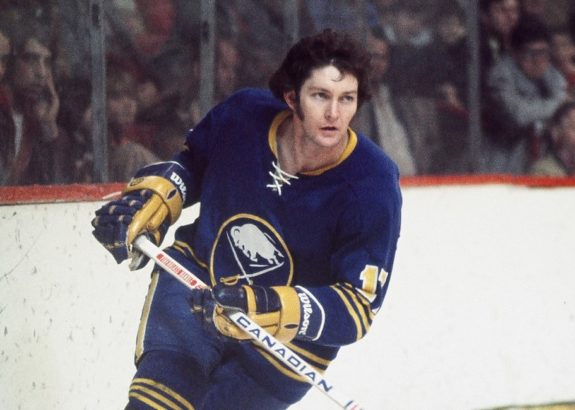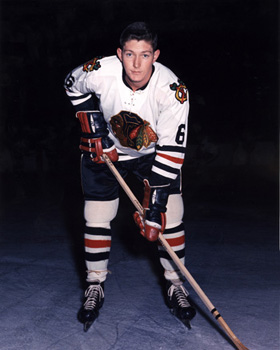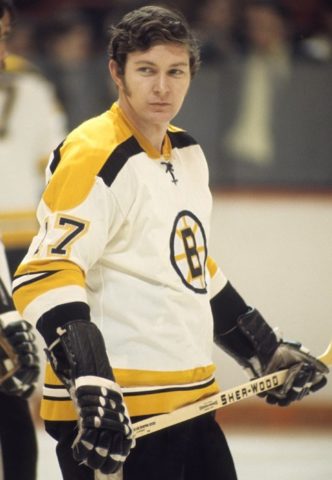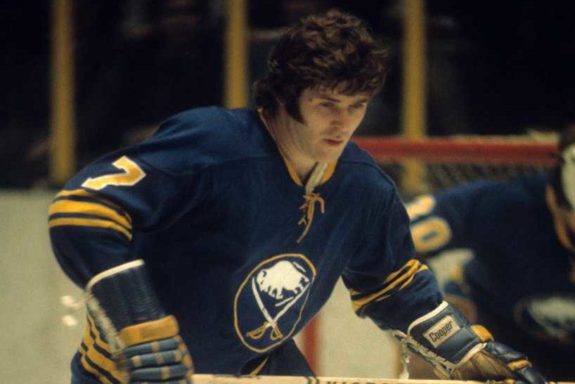The Buffalo Sabres made it to the Stanley Cup Final in only their fifth season of existence. The first thought regarding the team’s ability to do so typically calls to mind Buffalo’s fabled “French Connection” line of Gilbert Perreault, Rick Martin and Rene Robert – arguably the most dominant forward line of the 1970s NHL.
As tremendous as that trio of francophones was, the Sabres possessed extensive talent in every facet of their roster as they made their Cup-run.
The 1974-75 squad was the first NHL team to have six 30-goal scorers – Perreault, Martin, Robert, Rick Dudley, Don Luce and rookie Danny Gare. Buffalo had hulking, stalwart defenders in the likes of Jerry Korab, Jim Schoenfeld, Bill Hajt, and Jocelyn Guevremont. There was bell-weathered goaltending too with Gerry Desjardins, Gary Bromley, and the acrobatic Roger Crozier. Wingnut players such as Brian “Spinner” Spencer, Larry Mickey, and Jim Lorentz helped to add the finishing touches.

One thing the Sabres did not posses, however, was a lot of Stanley Cup experience. The team had only been in existence since 1970-71, and 12 of their players on the roster for the team’s fifth season were Buffalo draft picks. Only four players on the 1974-75 team were in their 30s. With the exception of Lorentz, no other Sabre at the start of season had previously won a Stanley Cup.
On pace to finish at the top of the Adams Division and with a legitimate shot at a championship, Sabres’ General Manager Punch Imlach knew he needed to acquire more Cup-winning experience to permeate through his roster.
In late January of 1975, Imlach would do just that by acquiring 11-year NHL veteran Fred Stanfield.
Stanfield’s Previous Experience

A proven scorer well before coming to Buffalo, Stanfield began his NHL career in the days of the “Original Six”. The Toronto, Ontario native would make his debut with the Chicago Blackhawks during the 1964-65 season. Appearing in 58 games, Stanfield would record seven goals, 10 assists and 17 points in that time.
Used sparingly by the Blackhawks over the next two seasons, Stanfield was part of the monumental trade on May 15, 1967 which brought he, Phil Esposito, and Ken Hodge to the Boston Bruins in exchange for Gilles Marotte, Hubert “Pit” Martin and Jack Norris. The trade is still regarded as one of the most lopsided of all-time.
The move was more than ideal for Stanfield. The Bruins would have him centering the team’s second line between Johnny Bucyk and Johnny McKenzie. Stanfield would proceed to record six straight seasons of at least 20 goals, and earned a nod to the 1973 NHL All-Star Game as an injury replacement. This trio of Stanfield-Bucyk-McKenzie still must be regarded as one of the best second-lines to ever play.
Setting a career-high of 79 points (23-56-79) in 1971-72 while accumulating just 12 penalty minutes, Stanfield would finish fourth in NHL voting for the Lady Byng Trophy in recognition of skill combined with gentlemanly play.
Most importantly to his time in Boston, Stanfield was a member of both Stanley Cup-winning Bruins teams in 1969-70 and 1971-72. He routinely worked the point on a devastating Bruins’ power play during these seasons, and was regarded for his efforts as a steady contributor on a team chock full of star power.
Leading up to the Trade

The Bruins would be hard-pressed for a goaltender following Hall of Famer Gerry Cheevers’ departure to the WHA in the Fall of 1972. That 1972-73 season, Boston’s goaltending was primarily handled by 37-year-old Eddie Johnston, a 36-year-old perennial minor leaguer in Ross Brooks, and at the age of 44, one of hockey’s all-time greats in Jacques Plante. The Bruins would subsequently suffer an opening round playoff elimination, despite being defending Cup champs.
Fearing a repeat the following season and in an effort to get much younger in his goal crease, Boston general manager Harry Sinden traded the reliable Stanfield to the Minnesota North Stars in exchange for 23-year-old netminder Gilles Gilbert.
Now aged 29, Stanfield’s time with the North Stars was rather fleeting. He would play one full season in Minnesota in which he tallied 16 goals in 71 games, and finished fifth (16-28-44) on the team in scoring.
After turning 30, he would begin the 1974-75 season registering eight goals, 18 assists and 26 points in 40 games before the Sabres acquired his services.
Finding His Way to Buffalo
On Jan. 25, 1975, Imlach would ship an underachieving right-winger Norm Gratton along with future considerations to the North Stars in exchange for Stanfield. At the time, Minnesota likely felt that they were getting the better end of the deal.
Despite bouncing around from the New York Rangers to the Atlanta Flames, and then to Buffalo, Gratton was a heralded first-round draft choice – 11th overall in 1971 – and was only 24 years old. After landing in Minnesota, he put together the finest performance of his brief NHL career.
Gratton would tally 14 goals and 12 assists for 26 points in 34 games. Factoring in his 11 points while with Buffalo (3-6-9), and Gratton was the fourth highest scorer on the North Stars roster. Despite any positive indications this may have given, Gratton only played 32 more games in the NHL after the 1974-75 season.
Stanfield, on the other hand, flourished with the high-flying Sabres. Demonstrating shades of his younger self, he scored at better than a point-per-game pace after he arrived in Buffalo. In Stanfield’s 32 games with the “Blue & Gold”, he promptly scored 12 goals and 21 assists for 33 points. When including the eight goals he scored while still with Minnesota, 1974-75 would be Stanfield’s seventh and final 20-goal season in the league.
It was not uncommon either for Stanfield to share some of the “French Connection’s” workload either. In an 80-game schedule, Perreault (68 games), Martin (68) and Robert (74) all missed some playing time due to injury. Stanfield’s own offensive prowess and his experience allowed head coach Floyd Smith to utilize his newly acquired veteran for bridging the gap on his top line.
Specific Sabres Performances
We take a look now at a handful of Stanfield’s more noteworthy games in a Sabres uniform from that 1974-75 season:
Jan. 30, 1975:
Stanfield would make his debut for Buffalo in a game against the New York Rangers. Perreault was out of the lineup due to injury, which meant that the team’s newest centerman covered the duties between Martin and Robert.
The Sabres would put forth a 6-3 victory over the “Blueshirts”. Capitalizing on New York infractions to Brad Park and Jean Ratelle, Stanfield set up two power play goals for Buffalo – one by Lorentz and one by Martin. He would finish with a pair of assists in his first game as a Sabre.
Feb. 4, 1975:
On the road in Detroit and with Perreault still out, the Sabres would defeat the Red Wings in solid fashion by a score of 6-1. Buffalo went up 6-0 by the end of the second period and never looked back. Stanfield scored the team’s fifth of the game – his first goal in a Buffalo uniform – with assists to Guevremont and Robert.
Mar. 5, 1975:
Facing the Rangers again – this time inside the confines of Madison Square Garden – the Sabres put another six goals by New York, and earned a 6-3 victory. Stanfield would pick up three helpers on the night, as he helped set up Lorentz twice and a lone tally from Martin. Buffalo peppered Rangers’ goalie Gilles Villemure for 40 shots, with Stanfield accounting for four of those and Martin accounting for nine.
Mar. 16, 1975:
Playing in Maple Leaf Gardens, the Sabres completely mopped the floor with Toronto by a score of 11-3. Stanfield would equal his career high of five points in one game (1-4-5). Ironically, the only other time he recorded five points in one contest was against the inaugural Sabres on Dec. 10, 1970.

Filling in for Robert on the right side, Stanfield (1-4-5), Martin (3-1-4) and Perreault (3-3-6) combined for 15 points in the one game. Stanfield set up two goals for Martin and one for Perreault in the first period alone. Perreault and Martin returned the favor by assisting on Stanfield’s lone tally early in the second. Stanfield would then earn the primary assist on Perreault’s hat-trick in the third.
Playoff Performance
The Sabres would finish the 1974-75 regular season with a record of 49-16-15 for 113 points. They would win the Adams Division by a full 19 points ahead of the second place Bruins. Those same 113 points earned Buffalo the Prince of Wales Trophy as the top team in the Wales Conference during the regular season.
With the postseason underway, Stanfield was one of only six Buffalo forwards to play in all 17 playoff games that season. He did so on a bum leg as well.
“Nobody outside the team knew I played seven games with a hairline fracture of my right ankle,” Stanfield said in Ross Brewitt’s book Sabres: 26 Seasons in Buffalo’s Memorial Auditorium. “It was never announced. We lost the series in six so what did it matter?”
“It happened in the semifinal against Montreal,” he went on to say. “I don’t remember who, but someone two-handed me across the skates, and in the excitement of the game, I didn’t feel any pain until later. I tried to ice the ankle down and wrap it real tight, but the injury was internal, and when we moved on to Philadelphia, I wasn’t able to push off or accelerate. I couldn’t help at all, offensively – couldn’t even score a goal. Of course, I was expected to play because of my Stanley Cup experience, and I did.”
During the opening round of the playoffs, the Sabres would eliminate the Chicago Blackhawks in five games, despite the brilliant goaltending of netminder Tony Esposito. The lone game that the Blackhawks won in the series required overtime to settle. Otherwise, the Sabres earned all four wins in regulation and outscored Chicago by a full 10 goals in the series.
In the semis, Buffalo would face one of their truest rivals in the Montreal Canadiens. This series was especially interesting in that it marked the last playoff appearances of 11-time Stanley Cup champion, Henri “The Pocket Rocket” Richard.
Richard and the Canadiens would push Buffalo to six games. Garnering Game One and Game Five victories in overtime, the Sabres were able to dispel a Montreal team that consisted of numerous Hall of Famers such as Richard, Ken Dryden, Yvan Cournoyer, Jacques Lemaire, Steve Shutt, Larry Robinson, Serge Savard, Guy Lapointe, and “The Flower” Guy Lafleur.
To Stanfield’s credit, he gave his finest playoff performance that year in the series against Montreal. He went 1-3-4 in scoring through the six games.
Unfortunately, Stanfield’s injury vastly limited his ability to contribute in the Stanley Cup Final against the “Broad Street Bullies”, the Philadelphia Flyers. He would go pointless through the 6-game Final, and finished the series as a minus-1. Backstopped by the Conn Smythe-winning goaltending of Bernie Parent, the Flyers would capture the Cup over the Sabres on Memorial Auditorium ice.
Wrapping up His Professional Career
Stanfield played three more seasons for the Sabres following the team’s ’75 Cup run. However, as age caught up with him his numbers would drop each season. Stanfield scored 18 goals for Buffalo in 1975-76, only to see those totals fall down to nine, and then just three in 1977-78.
He would wrap up his professional career with one final season in the AHL for the 1978-79 Hershey Bears, Buffalo’s top minor league affiliate at the time. Playing in 50 games, Stanfield proceeded to score 19 goals and 41 assists for 60 points. He would retire partway through the season, but would assume the interim head coaching duties of the team for the rest of the 1978-79 campaign. Stanfield would help mentor up-and-coming Sabres youngsters in the likes of Tony McKegney, Richie Dunn, and Larry Playfair.
When all was said and done, Stanfield had played 914 NHL regular season games – 248 of those as a Sabre. He also totaled 211 goals, 405 assists and 616 points across his time in the league.
Stanfield still lives in the Buffalo area and has remained an active member of the Buffalo Sabres Alumni Association. He has also owned and operated “Stanfield’s Office Furniture” for many years following his retirement.
Though his playing time in Buffalo took place during the back half of his career, Fred Stanfield’s value to the Sabres rings true – particularly during what has remained thus far their best shot at winning the Stanley Cup.